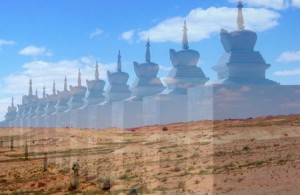Monday
Opinion PiecesPractically, Be Generous
 This article is part two of Simply, Be Generous, previously posted on the Shambhala Times, by Jonathan Hanna.
This article is part two of Simply, Be Generous, previously posted on the Shambhala Times, by Jonathan Hanna.
There are said to be three kinds of generosity: giving material goods, giving protection from fear, and giving the dharma. Throughout the history of buddhadharma the teachings have been freely offered as an act of generosity. The notion of paying for teachings is a recent encroachment of the “materialistic outlook” that “predominates everywhere”. Of course, the teachings are not free and never have been, even in the time of the Buddha. The generosity of major benefactors provided food and shelter to the early sangha. In addition, due to their deep appreciation for the preciousness of the profound teachings, disciples have always made personal offerings, often substantially larger by proportion than the amounts we pay today. Yet access to the teachings has never been based on the size of the offering.
Some might say that this model is not possible in the modern world. But if we examine closely, it is the materialistic worldview that defines our sense of what is possible in this regard. We have no cultural corollary for these traditional practices. The ideas are foreign to us so they have not yet found a foothold in our culture. Through contemplation and experimentation we must unlock the treasure chest of these profound practices in order to bring them into our world; not because they are Tibetan or traditional, but because they lie at the heart of the transmission. The forms that arise from this contemplation need not be exact replicas of the Tibetan but they must be based on the same profound view of reality.
Our institutions must sustain themselves within current legal and financial conventions. Before they can fully embrace policies that reflect such radical generosity they must know that we, the citizens of Shambhala, actually want to participate in creating such a culture. We must be willing to do our part as individuals.
Joining Heaven and Earth
 Transcendent generosity, based on the realization of threefold purity, is not an act so much as a quality of being. It is the main practice of bodhisattvas on the first bhumi, called Perfect Joy, due to their direct realization of emptiness. Rather than giving up possessions, transcendent generosity is about not possessing anything in the first place, including our own body, speech and mind, our thoughts and feelings, even our very perceptions. Yet, those of us who do not have such perfect realization can still engage the transformational power of generosity. Since we do believe in our possessions, we have the practice of relative generosity to counteract self-clinging. In the Introduction to The Middle Way (Madhyamakavatara), Chandrakirti says:
Transcendent generosity, based on the realization of threefold purity, is not an act so much as a quality of being. It is the main practice of bodhisattvas on the first bhumi, called Perfect Joy, due to their direct realization of emptiness. Rather than giving up possessions, transcendent generosity is about not possessing anything in the first place, including our own body, speech and mind, our thoughts and feelings, even our very perceptions. Yet, those of us who do not have such perfect realization can still engage the transformational power of generosity. Since we do believe in our possessions, we have the practice of relative generosity to counteract self-clinging. In the Introduction to The Middle Way (Madhyamakavatara), Chandrakirti says:
(16) Giving, void of giver, gift, receiver,
Is called a paramita that transcends the world,
But when attachment to these three occurs,
The teachings have defined it as a perfect act of worldly ones.
Although we may not have stable, direct realization of emptiness, through study, contemplation, and meditation we can understand it rationally and have glimpses. As we gain confidence in the view, it gives us courage to practice, like learning to swim; although we have heard about it the deep water is still terrifying. Trusting that it is possible we cautiously try it out and bit by bit, accompanied by fear, we learn to swim. Just as believing swimming to be possible is not swimming, it is not enough to simply understand egolessness or believe in basic goodness. There is no trick to crossing over from the idea of it to the reality of it, we simply do it or do not, like a Jedi. It requires making a firm decision. It can take a long time or it could be very quick. The more we resist the longer it will take and the harder it will seem.
By combining confidence in the view of absolute generosity with daring in the practice of relative generosity, the path becomes workable and earthy. It comes alive. We create an opening for profound possibilities to unfold. The following pith instruction from Chogyam Trungpa Rinpoche describes the practical experience of this union of absolute and relative:
The everyday practice is simply to develop a complete acceptance and openness to all situations and emotions, and to all people, experiencing everything totally without mental reservations and blockages, so that one never withdraws or centralizes into oneself. This produces a tremendous energy which is usually locked up in the process of mental evasion and a general running away from life experiences.
We can practice generosity toward the field of merit (which is the three jewels) by making offerings, or toward the field of benefit (sentient beings) by providing for their needs. It is impossible to say that one is more important than the other. They are both essential. Making offerings to the three jewels has to do with receiving the blessings of the lineage and accumulating merit. Practicing generosity toward beings, the field of benefit, relates to how we manifest as bodhisattva-warriors. A rough analogy might be that offerings are like turning on the spigot and generosity toward beings is like pointing the hose toward the plants that need water.
Generosity Begins at Home
When learning to swim we do not begin by dropping straight into the middle of the ocean. Likewise, when practicing generosity we begin with small acts, frequently repeated. We all have responsibilities to our environment. Parents, children, spouses, extended family and friends are all beings to whom our karmic responsibility is self-evident. As aspiring bodhisattvas, our practice of generosity is the same for all beings. But due to karmic connections, certain beings and situations naturally present themselves with greater frequency, consistency, and urgency than others.
In the Shambhala teachings, our domestic situation is not created for our own comfort or self-aggrandizement, but as an intensive practice environment. In the Hinayana view this means constantly surrendering ego and self-absorption. In the Mahayana it means manifesting and cultivating an environment dedicated to the benefit of others (the Mahayana practice is clearly dependent on the Hinayana). It is the mandala within which our commitment to selflessness and generosity directly benefits others by creating conditions that are conducive to their temporal and spiritual fulfillment. This is the notion of the Kalapa Court. Having established our Court, we take our seat not by being treated like royalty but by utterly committing ourselves to the service and protection of others. Surrendering our agenda and sacrificing our own comfort are the basic strokes we practice to swim in the sea of generosity. The more wholeheartedly we take our seat within the challenges of life, the more wholesome and authentic our court will be, and the greater our capacity to extend our rule with benevolence and magnanimity will be.
Ironically, it is actually easier to work with absolute generosity than relative generosity, because relative generosity depends on conditions. Absolute generosity does not. Simply giving up our territorial pride and allowing the “tremendous energy which is usually locked up” to be available to others, without an agenda, is the most powerful and most essential generosity. This is what will determine whether we fulfill the vision of Chogyam Trungpa Rinpoche and the purpose of the Shambhala teachings or not. The Sakyong has emphasized this with increasing urgency through the years in a variety of ways. From the Treatise on Society and Organization:
We must work to overcome our own self-absorption and our habitual reliance on anger, jealousy, and so forth… we must now realize that the ongoing low level of aggression – in the form of jealousy, fixation, pride, and so forth – is the element that gnaws away and fundamentally weakens society.
From the Letter of the Morning Sun:
This (Shambhala) community could occur because its individual members participated fully in creating a culture of kindness, generosity, and courage. Therefore, their innate good qualities were able to manifest… our ability to benefit, influence, and inspire the world will come directly from our ability to manifest kindness, embody goodness, and create a genuine feeling of delightfulness.”
From this ground material, generosity arises naturally as a joyful celebration. Our life as a whole becomes simpler and more joyful. We find we actually need very little, and in fact, attachment to what we think we need or enjoy actually blocks our own fulfillment. That is the tragic irony of ego. Absolute and relative generosity free us from the encumbrance of materialism’s false promises and we take delight in basic goodness. Hence the practice of a bodhisattva is said to accomplish the two benefits of self and other. Bringing together the absolute view of generosity with the practice of relative generosity imbues our actions with a quality of lightness and transparency like beautiful stained glass with the Great Eastern Sun shining through.
It takes courage to live this way, but the reward is priceless.
Having explored the individual practice of generosity. Part 3, the next essay in this series, will examine offerings and aspirations associated with the practice of generosity.
—
 Jonathan Hanna received the Shambhala name Garuda Sun from Sakyong Mipham Rinpoche. Although he has received teachings from many other lineage holders, particularly Her Eminence Mindrolling Jetsun Khandro Rinpoche, the Shambhala terma of Chogyam Trungpa Rinpoche is his primary heart practice. He has made numerous visits to Tibetan communities in India where the practice of generosity is inseparable from the traditional culture of Buddhism. Inspired by this, he has generated the wish to see this approach to generosity take root and flourish within the Shambhala community, both in the way our institutions offer the teachings and in the way individuals support the teachings. Several years ago, he helped to organize a series of conferences called Active Compassion which (among other things) sought to explore and model forms that would foster a more pervasive practice of generosity. This essay was written at the urging of one of our shastris, made during the recent Kalapa Governance Gathering in Halifax. May it help give rise to profound generosity throughout Shambhala.
Jonathan Hanna received the Shambhala name Garuda Sun from Sakyong Mipham Rinpoche. Although he has received teachings from many other lineage holders, particularly Her Eminence Mindrolling Jetsun Khandro Rinpoche, the Shambhala terma of Chogyam Trungpa Rinpoche is his primary heart practice. He has made numerous visits to Tibetan communities in India where the practice of generosity is inseparable from the traditional culture of Buddhism. Inspired by this, he has generated the wish to see this approach to generosity take root and flourish within the Shambhala community, both in the way our institutions offer the teachings and in the way individuals support the teachings. Several years ago, he helped to organize a series of conferences called Active Compassion which (among other things) sought to explore and model forms that would foster a more pervasive practice of generosity. This essay was written at the urging of one of our shastris, made during the recent Kalapa Governance Gathering in Halifax. May it help give rise to profound generosity throughout Shambhala.




